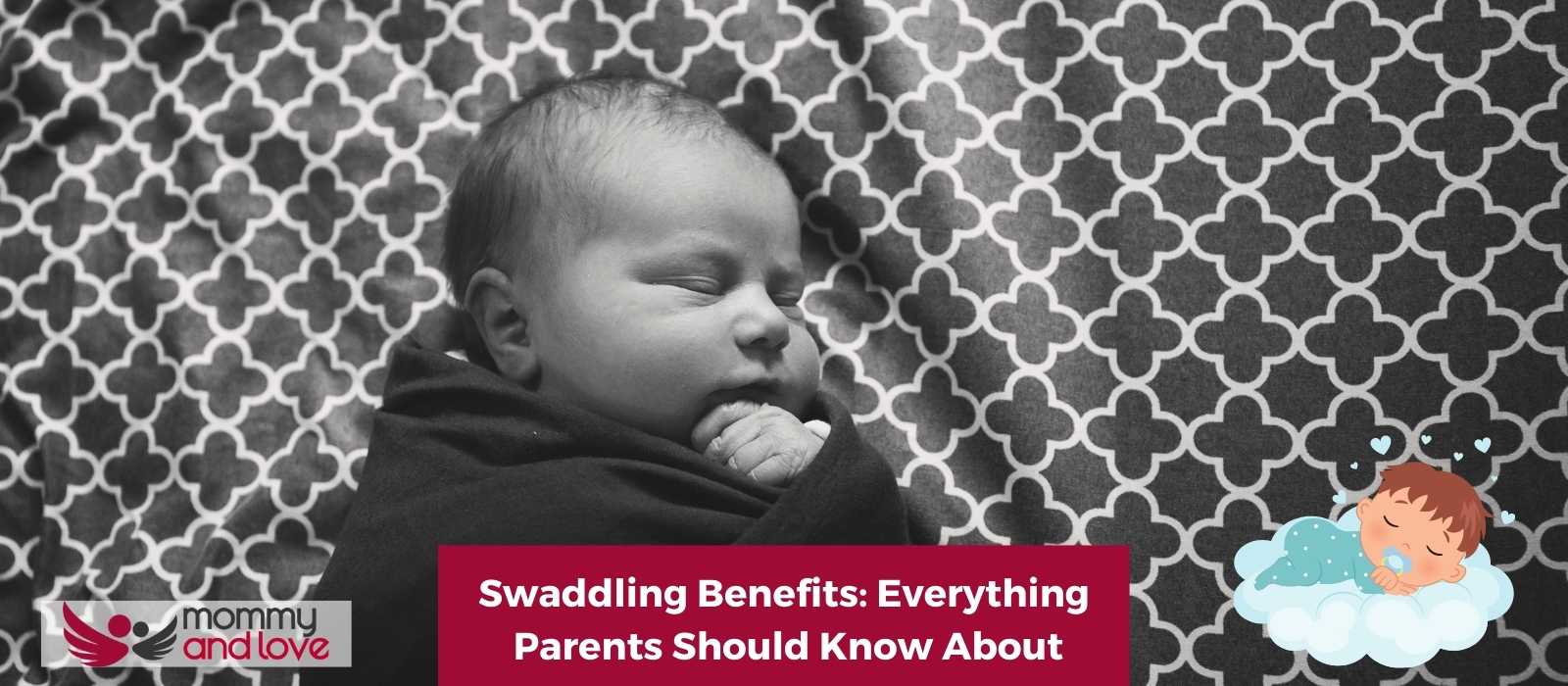Swaddling is a practice that has been used for centuries in many cultures around the world to calm and soothe infants. Swaddling can help newborns to sleep better, regulate their body temperature, and improve their overall health.
Is Swaddling Safe?

Swaddling is a practice to soothe and comfort a crying baby. It involves wrapping the newborn baby in a blanket or cloth so that the baby’s legs and arms are restricted.
Swaddling helps promote sleep and is generally considered safe. However, there are some risks associated with it.
These include the baby’s risk of becoming too warm, the risk of the baby’s limbs becoming constricted, and the risk of the baby rolling over while swaddled.
According to International Hip Dysplasia Institute, wrapping the baby too tightly or improper swaddling may potentially lead to hip dysplasia, a condition in which the hip joint is not properly formed. This can lead to pain and disability.
Hip dysplasia can happen when you put too much pressure on the baby’s hips, restrict the movement of the hips, or increase the temperature around the hip joint, which can make the joint more flexible and susceptible to injury.
What Are the Benefits of Swaddling My Baby?
The idea behind swaddling is that the snug wrap will help soothe the baby and mimic the feeling of being in the womb. It can have some real benefits for babies when done safely and properly.
Here are some of the benefits of swaddling:
- provide your baby with a sense of security and comfort
- helps a baby sleep since swaddling recreates the same feeling of being in the womb
- regulate your baby’s body temperature
- protects them from their natural startle reflex during sleep
- calms them down during a colic episode
- eases anxiety
- fewer unnecessary wake ups
- prevents the face from scratches as your baby sleeps
- teaches babies to self-soothe
How to Properly Swaddle a Baby
It is important to make sure that you swaddle your baby properly in order to provide them with the safest and most comfortable experience possible.
Here is a step-by-step guide on how to do so:
- Choose a flat surface on which to lay out the baby swaddle blanket. Make sure that there are no wrinkles in the fabric.
- Place your baby on their back in the center of the swaddle blanket.
- Fold the top corner of the swaddle blanket down and bring the bottom corner of the blanket up and over your baby’s feet, tucking it underneath their body.
- Take the right side of the blanket and fold it over your baby’s chest, making sure that their right arm is free.
- Now take the left side of the blanket and fold it over, tucking it underneath your baby’s body. This should feel snug but comfortable for your baby.
Safety Tips for Swaddling a Baby

Yes, it’s adorable to wrap your little bundle of joy into a baby burrito. Swaddling a baby can be a great way to help them feel secure and calm.
However, it is important to follow some safety guidelines when swaddling your baby, in order to avoid potential hazards.
Here are a few safety tips for swaddling a baby safely and effectively.
- Always use clean swaddle blankets when swaddling your baby.
- Make sure the swaddling sheet or blanket is not too tight. It should be snug, but not too tight.
- Get your her out of being swaddled if your baby shows signs of overheating such as sweating, flushed cheeks, rapid breathing, and damp hair.
- Wrap your baby firmly and remember that a snug swaddle doesn’t mean tight.
- Be careful not to wrap the blanket too tightly around the baby’s head or neck.
- Never leave your baby unattended while he or she is swaddled. You’ll never know if your newborn child starts to roll over in her sleep.
- Check on your baby often to make sure the blanket has not become loose.
- If you are using a lightweight blanket, be sure to tuck it in securely so that it does not come loose and cover your baby’s face.
- During hot weather conditions, make sure to take your baby’s temperature regularly.
- Your baby’s crib should be free from loose pillows, blankets, and stuffed animals.
- When swaddling your baby for sleep, always place your baby on his or her back.
- Keep your baby safe by keeping away heavy blankets away from the baby’s face to avoid the risk of suffocation while your little one is sleeping.
When to Stop Swaddling?
The AAP recommends stopping swaddling a baby at 2 months or when the baby starts to attempt to roll over, whichever happens first. Swaddling can help babies feel calm and can promote better sleep. However, once the baby begins to attempt to roll over or try to break free from the swaddle, swaddling can increase Sudden Infant Death Syndrome or SIDS risk.
Conclusion on Benefits of Swaddling
Although swaddling healthy infants may seem like an old-fashioned technique, it can offer many benefits for a baby if done properly and safely.
If you’re looking for ways to soothe your little one or want to help your baby sleep through the night, consider giving swaddling a try. But swaddle safely! Follow the proper safety guidelines and know when it’s time to stop swaddling to avoid any potential problems.
If you are still on the fence about swaddling, you can always talk to your baby’s pediatrician or doctor for expert advice and parenting information.
FAQs on Swaddling a Baby
Does a Swaddled Baby Sleep Better at Night?
Swaddling is often used as a way to help calm a fussy baby and has been shown to be an effective method for getting babies to sleep through the night. So yes, swaddled babies tend to sleep longer and easier at night which is good for baby growth and development.
Swaddling can help to prevent babies from waking up due to their own startle reflex. The startle reflex is a natural reflex that babies have when they are startled, and can often cause them to wake up from a sound sleep.
Swaddling helps to keep the baby’s arms and legs from moving around, which can help to prevent the baby from being startled awake.
When you swaddle your baby, it helps to promote sleep by providing a sense of security and comfort for the child. The snugness of the swaddle can help to remind the baby of being in the womb, which can help to lull them into a deep sleep.
And of course, if the baby sleeps better, mom and dad sleep longer and better as well.
Do Swaddled Babies Have a Lesser Risk of Sudden Infant Death Syndrome?
There is no evidence to recommend swaddling as a strategy to reduce the risk of SIDS, according to the American Academy of Pediatrics (AAP). Swaddling may help babies sleep more soundly, but it should be done correctly and carefully to avoid increasing the risk of SIDS.
For instance, babies should be sleeping on their backs, the safest position, even when swaddled. Sleeping while swaddled and in the prone position can cause an increased risk of SIDS and suffocation.
How Do I Know if My Baby Doesn’t Want to Be Swaddled?
One of the most important things you can do as a parent is learning to listen to your baby. Every baby is different, and each one will communicate their needs in their own way. Some babies will let you know very clearly when they don’t want to be swaddled – they may cry or fuss, or try to wiggle out of the swaddle. Other babies may be more subtle, and you’ll need to pay close attention to their cues.
What Can Parents Do Instead of Swaddling?
If your baby does not like being swaddled, there are a few things you can do instead.
- Wrap in a thin blanket or towel. This will give them the same feeling of snugness without being as constricting. Don’t leave them unsupervised when you do this.
- You can also try holding them close to your body in a position that they feel comfortable in.
- Try using a white noise machine or other calming sounds to help soothe them.
Remember that not all babies want to be swaddled and that’s fine. What’s more important than swaddling is that your baby is safe and is sleeping at night.
Is It OK to Swaddle a Newborn With Arms Out?
Some parents find that their babies sleep better when they are swaddled arms free, so if this is the case for you, then go ahead and swaddle away! The decision to swaddle the baby with arms in or out should be based on the baby’s individual needs and preferences.

This article was written by: Gian MIller – Full-Time Writer, Baby Whisperer & Dad of 3.
Gian spends a lot of his time writing. A self-proclaimed baby whisperer, Gian has been through it all with his own children and is passionate about sharing his hard-won wisdom with other parents. When he’s not writing or changing diapers, you can find him playing the guitar or watching baseball (or preferably both at the same time).




